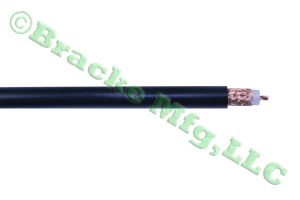Coaxial Cable Primer

Applications of Coaxial Cable
Coaxial cable is used to transmit radio frequency signals. Its applications include feedlines hooking up radio transmitters and receivers with their antennas, computer network (Web) connections, and distributing cable tv signals. One advantage of coax over other sorts of radio transmission line is that in an optimal coaxial cable the electro-magnetic field conducting the signal exists only in the space between the inner and outer conductors. This allows coaxial cable runs to be installed next to metal items like gutters without the power losses that sometimes occur in various other varieties of transmission lines. Coaxial cable also shields the signal from peripheral electromagnetic obstruction.
Description Of Coax
Coaxial cable conducts electrical signal using an inside conductor (generally a flexible solid or stranded copper wire) surrounded by an insulating layer and altogether wrapped by a shield layer, generally a woven metallic braid; the cable is often protected by an exterior insulating cover. Because of the shielding and insulating layers, electric and magnetic fields outside the cable are largely prevented from interfering with the signals inside the cable. This attribute makes coaxial cable a good option for carrying weak signals that cannot endure interference from the environment or for higher electrical signals that can’t be allowed to emit or combine into adjacent structures or circuits.
Common uses of coaxial cable include video and cable television distribution, RF and microwave transmission, and computer and instrumentation data connections.
The characteristic impedance of the cable (Z_0) is determined by the dielectric constant of the interior insulation and the radii of both the outer and inner conductors. A measured cable characteristic impedance is very important because the source and load impedance should be the same in order for optimal power transfer and minimum “Standing Wave Ratio”. Other vital properties of coaxial cable consist of attenuation as a voltage handling capacity, function of frequency, and shield reliability.



